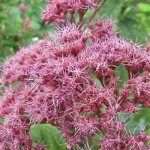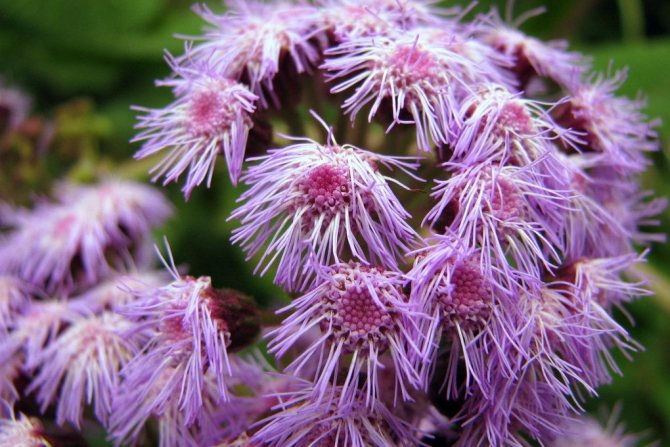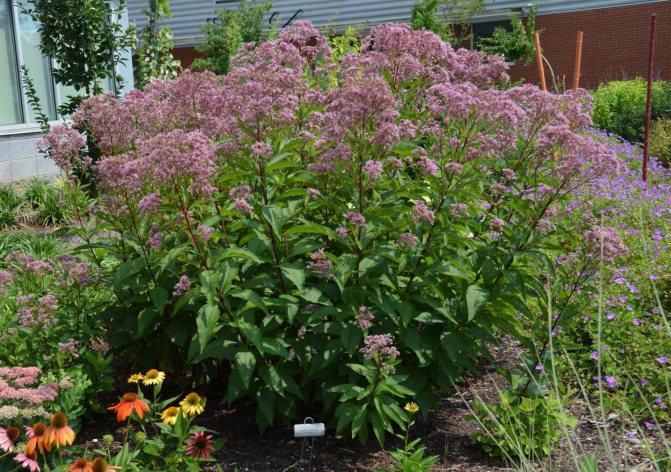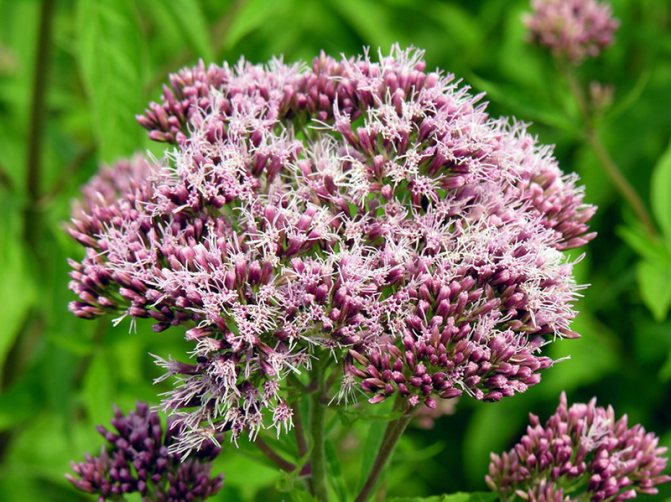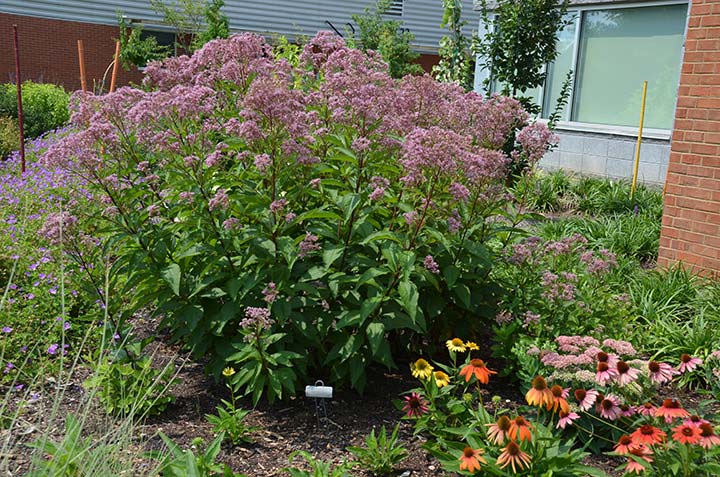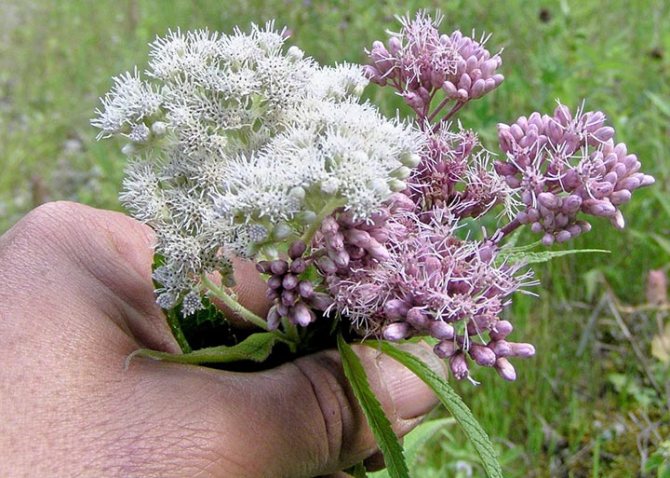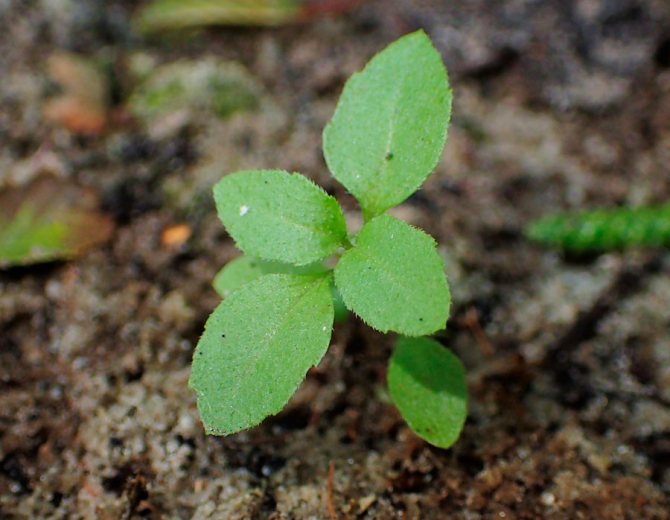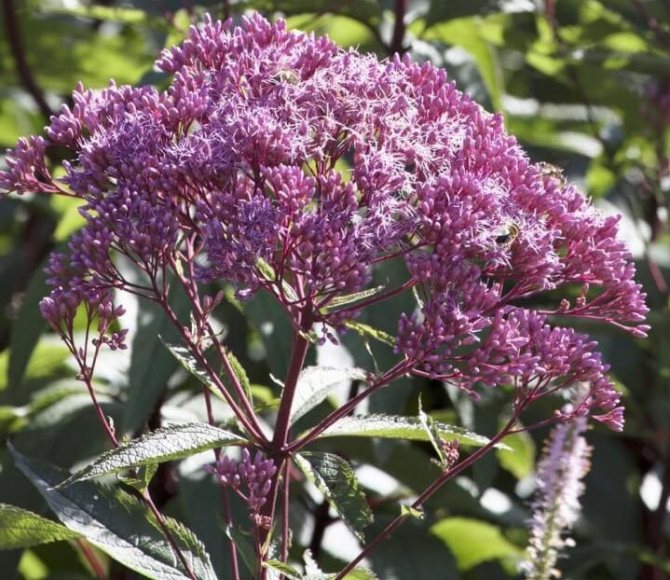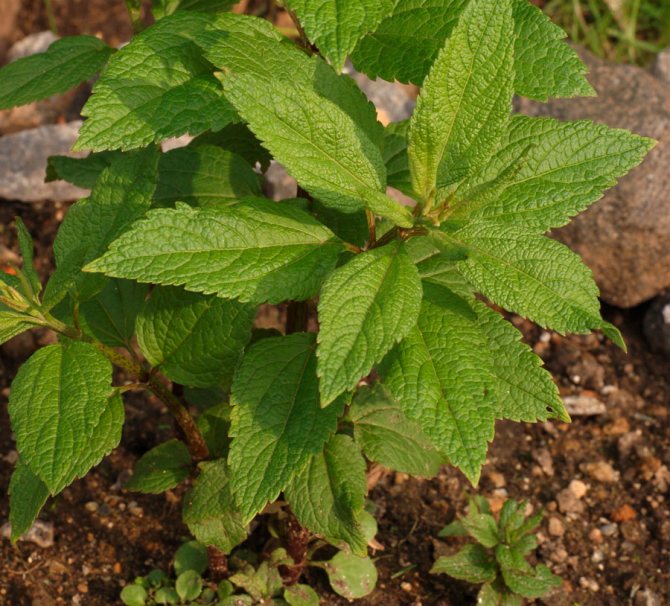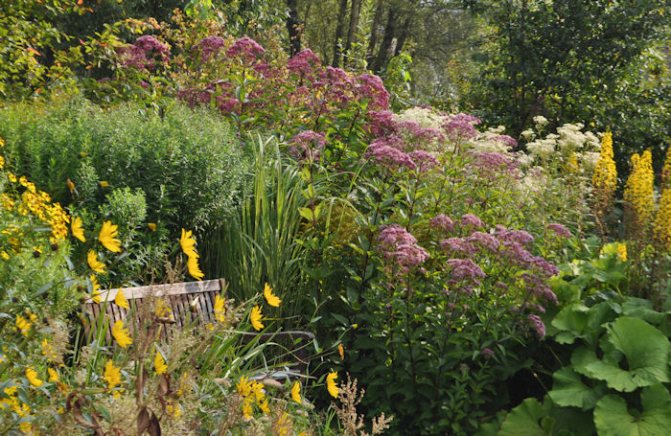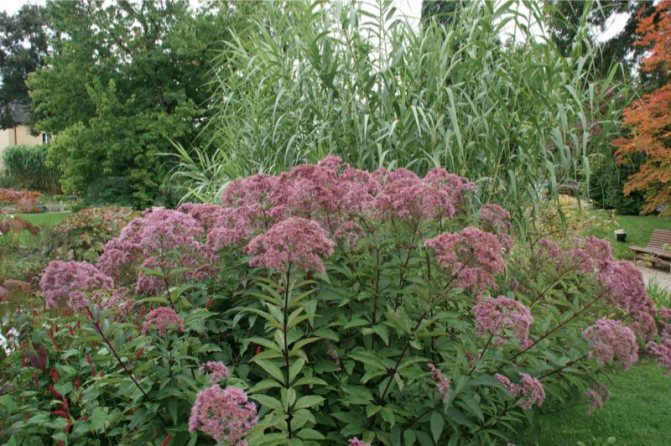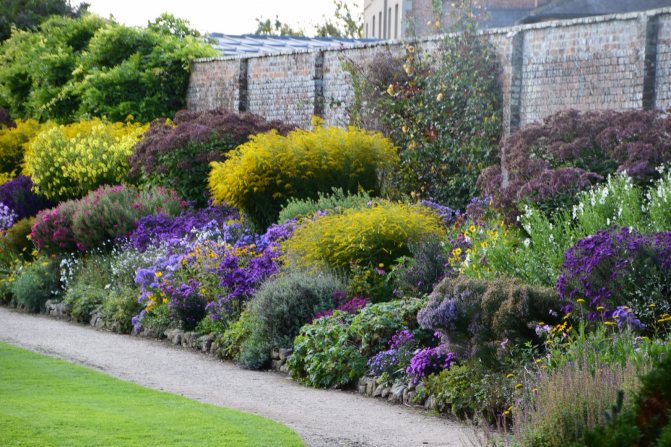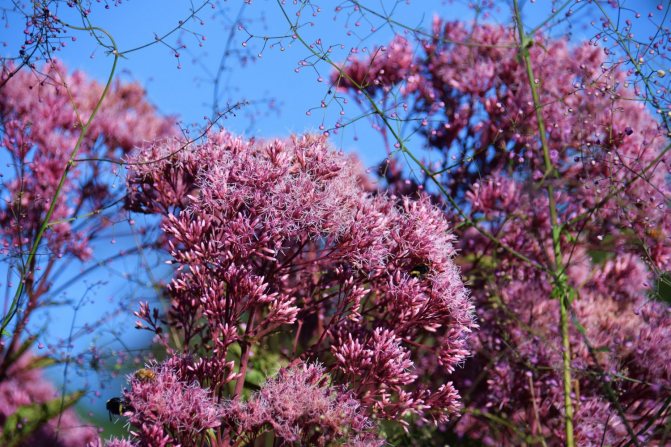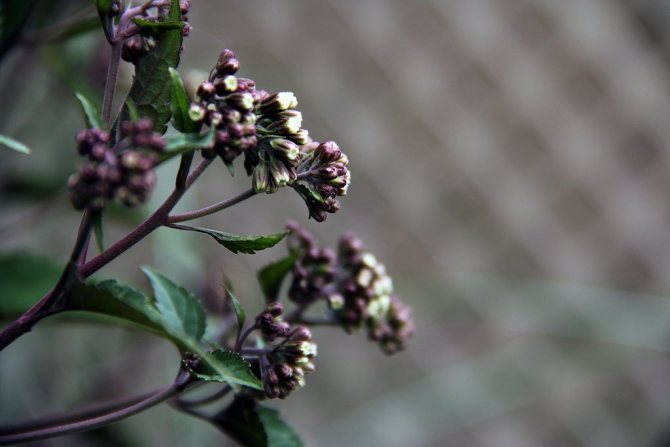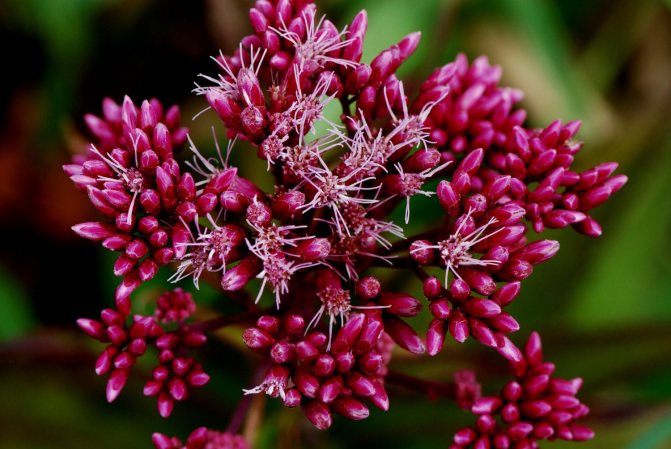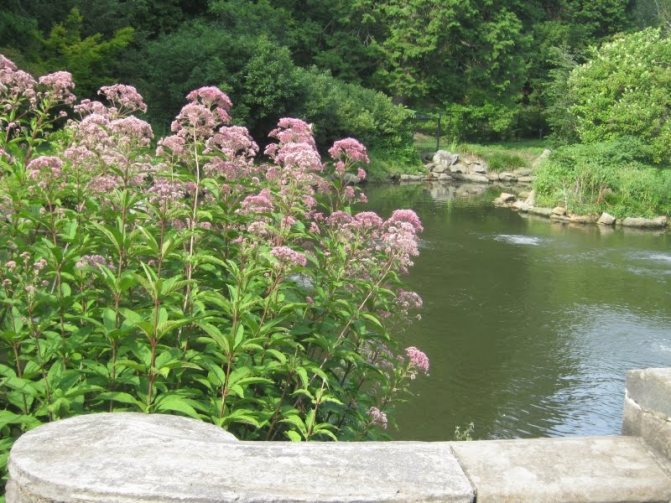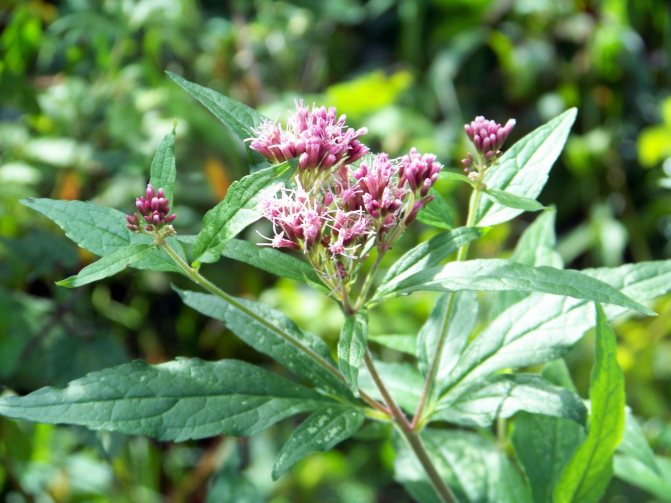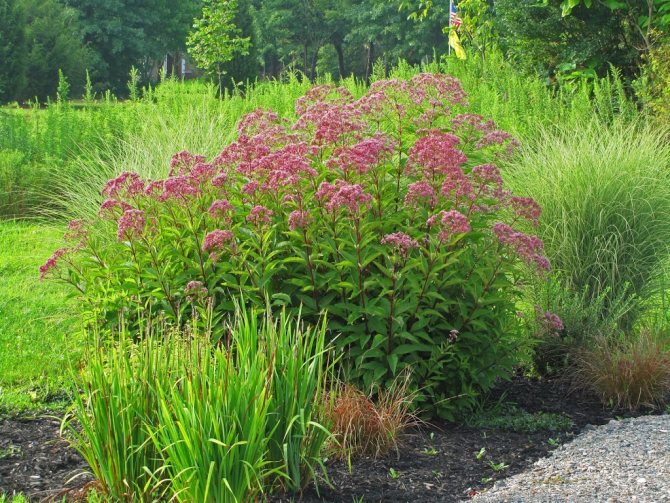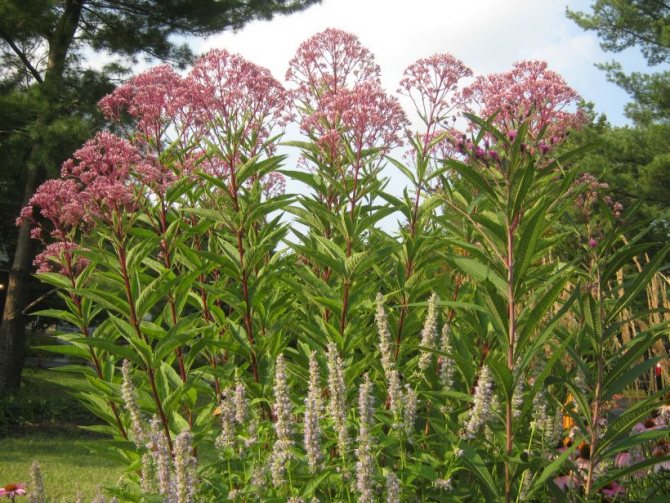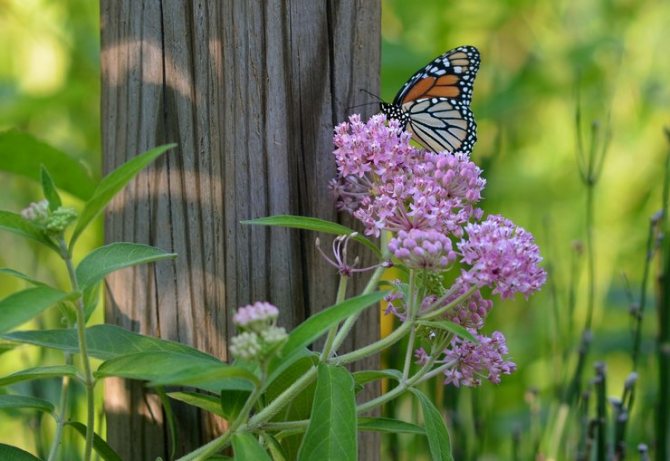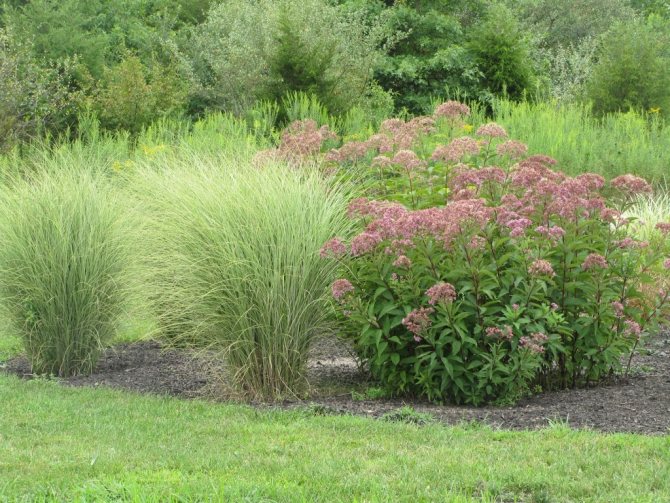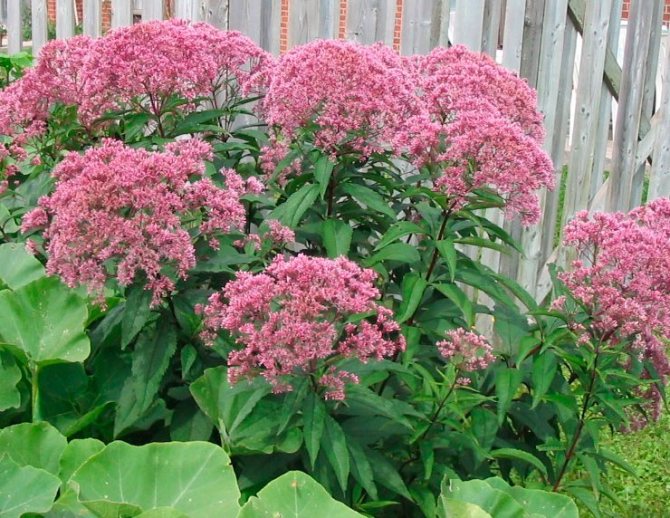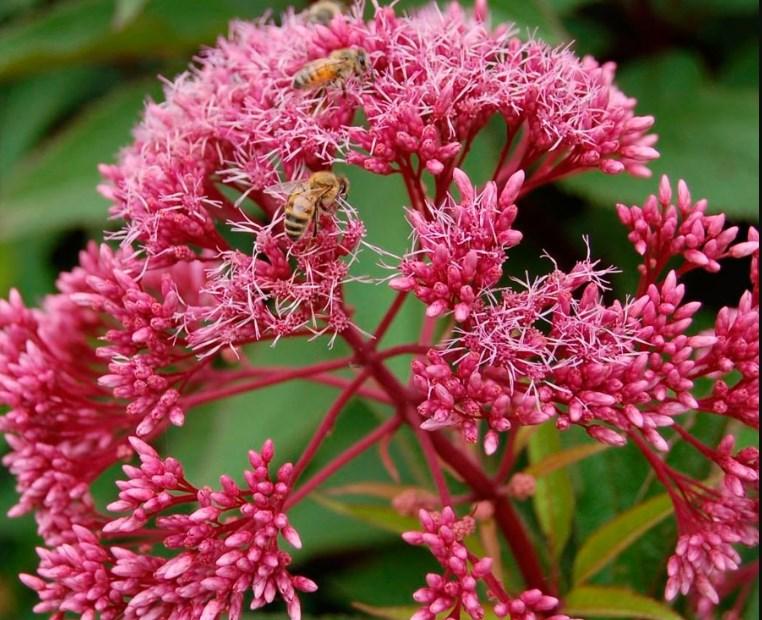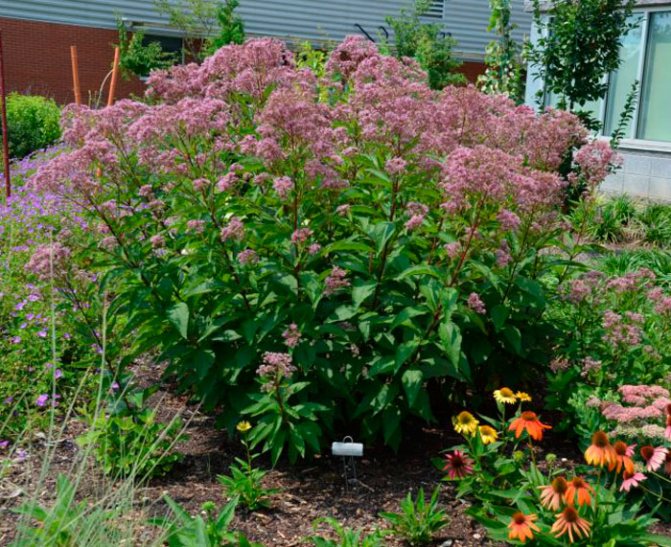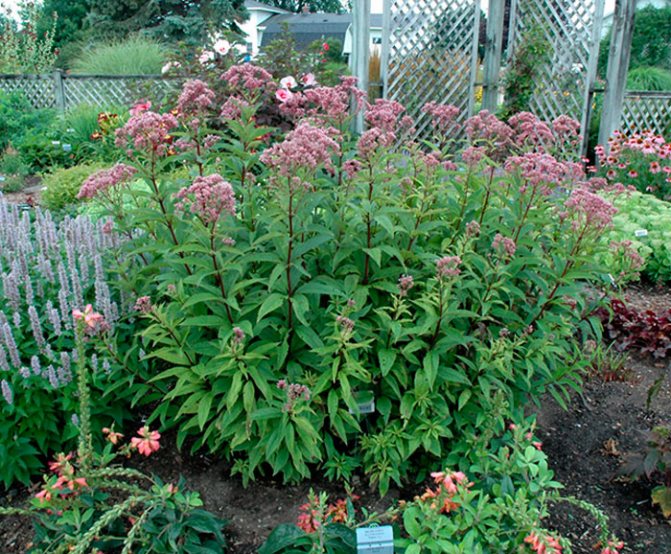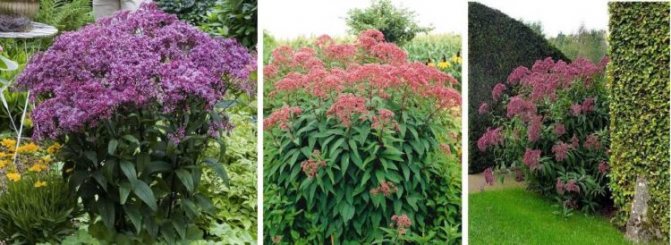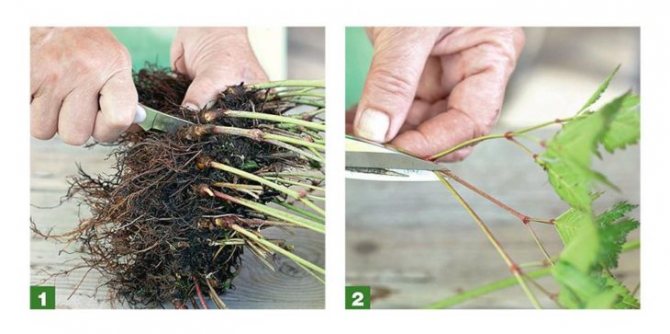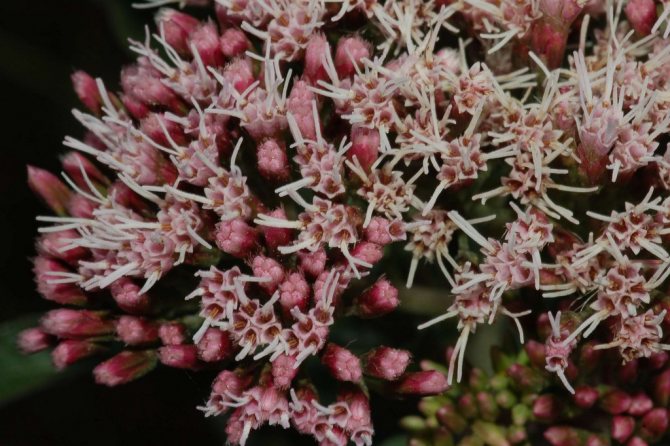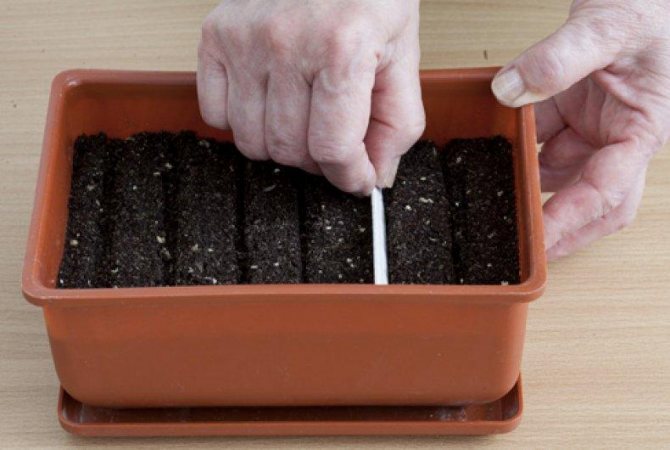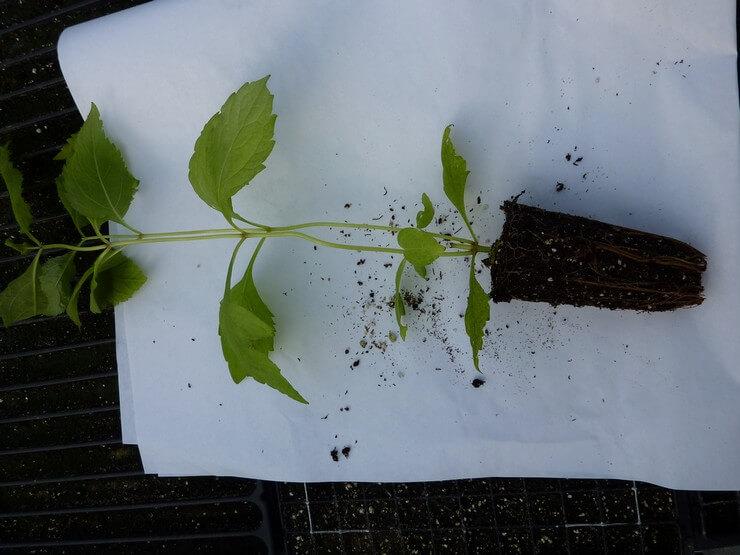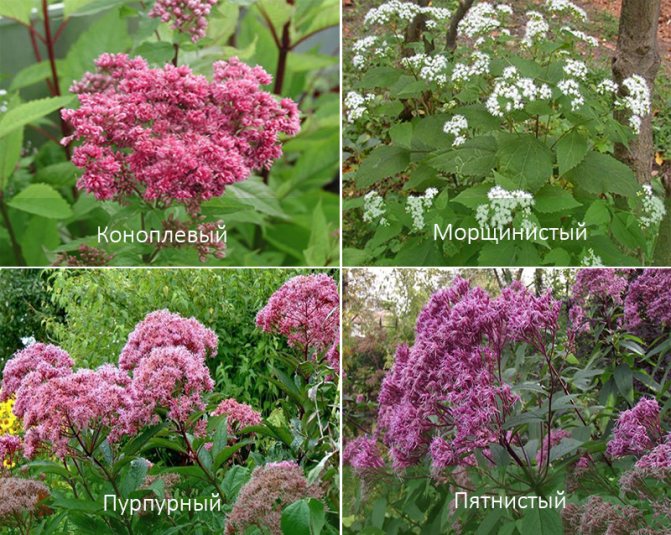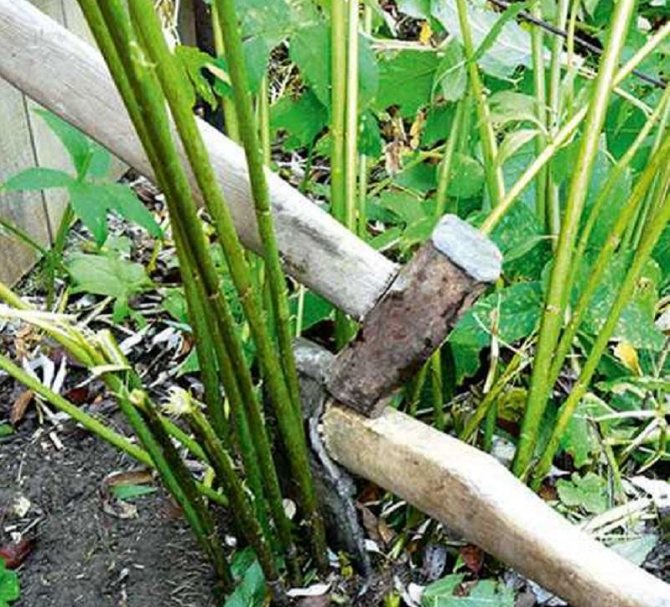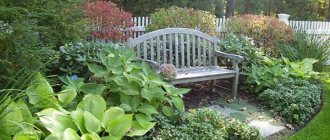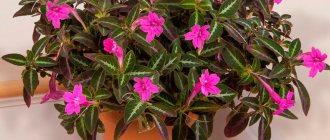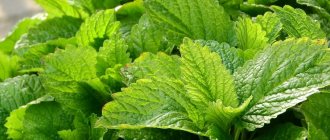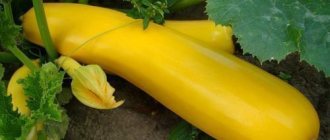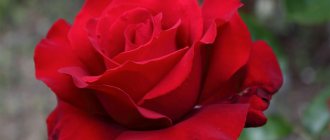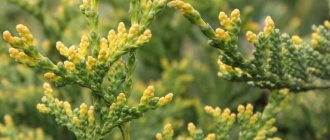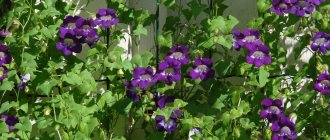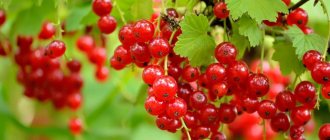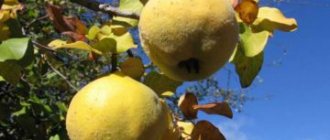Skeleton is a wonderful flowering type of plant that forms sprawling high thickets on the backyard. The plant is indispensable for creating long-term flowering compositions, however, Russian gardeners are not yet familiar with the steep.
Botanists call the stems "Evpatorium" in honor of the first of the ancient rulers - Eupator. The plant belongs to the genus Astrovye, it is found mostly in the sunny forests of hot Eurasia, in Africa and America. The plant attracts with graceful and long flowering, which, with proper care, continues until the very frost.
How to choose the right rump when buying
A specialized garden store is best suited to purchase a steep sap; this will give a certain guarantee of the quality of the planting material.
Rules for the selection of rhizomes
The goods sold must be in transparent packaging in order to be able to assess its quality according to the following criteria:
- There is no mold or rot on the rhizome.
- The roots are intact, without mechanical damage.
- The rhizome is firm, elastic, and at the same time unbreakable.
- When purchased in the springtime, swollen buds are visible.
Do not hesitate to carefully examine and touch the selected rhizome, it depends on whether the plant will take root in your area.
Seedling selection
Bone sap seedlings are usually sold in an individual pot. Take a close look at the state of the plant:
- The leaf is strong, cheerfully looking up. Softness and lethargy indicate a lack of watering.
- An earthen lump is moist, not overdried.
- The roots are hidden in the ground.
If the roots protrude from the container, such seedlings should not be purchased, they are unlikely to take root.
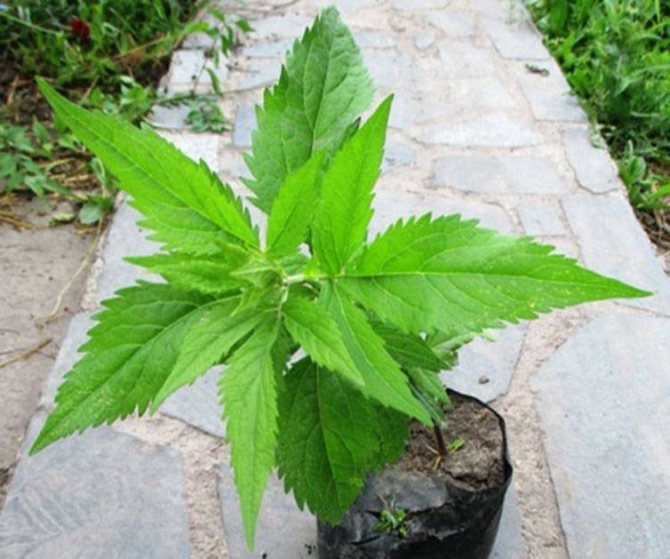
Selecting and preparing a landing site
In the wild, the steeple prefers moist soil.
Based on this, choose a low-lying, humid place for planting on your site, the shore of a pond or an artificial reservoir is especially well suited.
The height of the plant depends on how wet the earth is: the higher the humidity, the higher the bush.
Keep in mind! The sap will grow in breadth, so there should be a lot of free space for planting, about a square meter.
Illumination is important. This perennial loves the sun, it can grow in partial shade, but if it does not have enough lighting, it will not give flowers, it will look sickly and sickly.
Like most plants, this perennial needs loose, soft soil. On a sandy area, it will not grow, since sand almost does not retain water.
In order for the bush to delight with its appearance, powerful stems and lush flowering, plant it on fertile, humus-rich soil.
How to prepare the soil
Such a powerful plant requires increased nutrition.
To carry out the correct planting of the steep and further care in the open field, the bed must be prepared with special care:
- dig up the ground conscientiously, picking out all the weeds;
- cover up compost or humus in the garden;
- add sand to heavy clay soil, and dilute the sandy loam with clay to retain moisture longer;
- add mineral fertilizers with a long splitting period, they will nourish the plant for several years.
After that, level the surface of the bed and mark the planting holes so that there is at least 60 cm between them.
Application
Seeds, flowers and stethosis leaves have found their application in various branches of life. The bush bush will most often find its place in landscape design because of the beauty of its buds. But it is not only aesthetically beautiful, but also extremely useful in folk medicine, cosmetology and gardening. You can read more about this in this article.
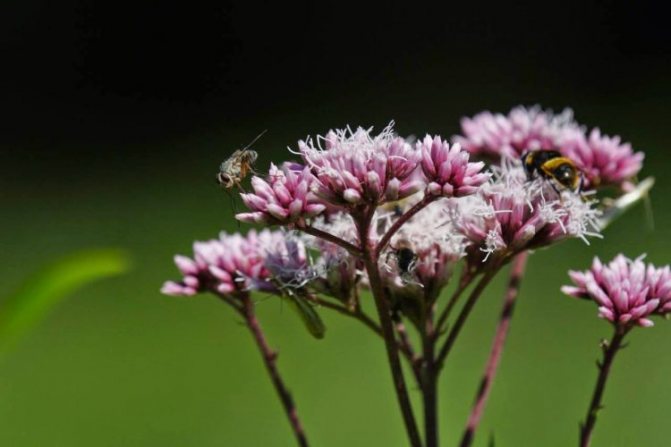

In medicine
This is a plant that definitely deserves a place on the list of antibacterial agents. A popular place has been taken by the stethosis in folk medicine, where it is used as a diuretic and anti-inflammatory agent. Small wounds, abscesses and purulent formations are treated with a decoction of water and stethosis.
At home
Sapwood is a perennial evergreen that will decorate any flower garden or flower bed. A beautifully flowering perennial can be used to decorate the shores of natural and artificial reservoirs. This placement has one significant plus: it will be much easier to care for a moisture-loving plant. Many designers note the architecture of the plant, decorating the facades of houses and outbuildings with it.
In cosmetology
The steeple extract is included in products designed for problem skin, in sunscreens and lotions with SPF factor.
Rules for planting a stethoscope in the country
Usually, the steep is planted with seedlings, cuttings or rhizomes after the establishment of warm weather:
- Dig holes at the designated places 0.25 m deep.
- Pour humus and bone meal into it, about a handful.
- Carefully remove the seedlings from the containers, being careful not to damage the stems and roots.
- Slightly stir the earthen ball on the roots so that they straighten: this way the plant will sooner grow.
- Place in the hole and sprinkle with earth so that the growth bud is covered by 5 cm; this will protect the seedling from freezing in winter.
- Water, being careful not to break the soil around the seedling.
- Cover the tree trunk with a layer of sawdust, humus or peat mulch to keep the soil moist and prevent weeds from growing.
Until the plant takes root, it should be watered more often, preventing the soil from drying out.
Bone sap is responsive to fertilization, but feeding can be started only after rooting.
Feed with complex mineral fertilizers such as Kemira Lux, Zdraven, nitroammofosk, after making an aqueous solution based on them.
Combination with other plants
This decorative bush looks spectacular in a mixborder, in a group planting with other shrubs, it can be used to cover an unseemly building or use it as a hedge.
It goes well with such large plants as Rogersia, Volzhanka, Astilba.
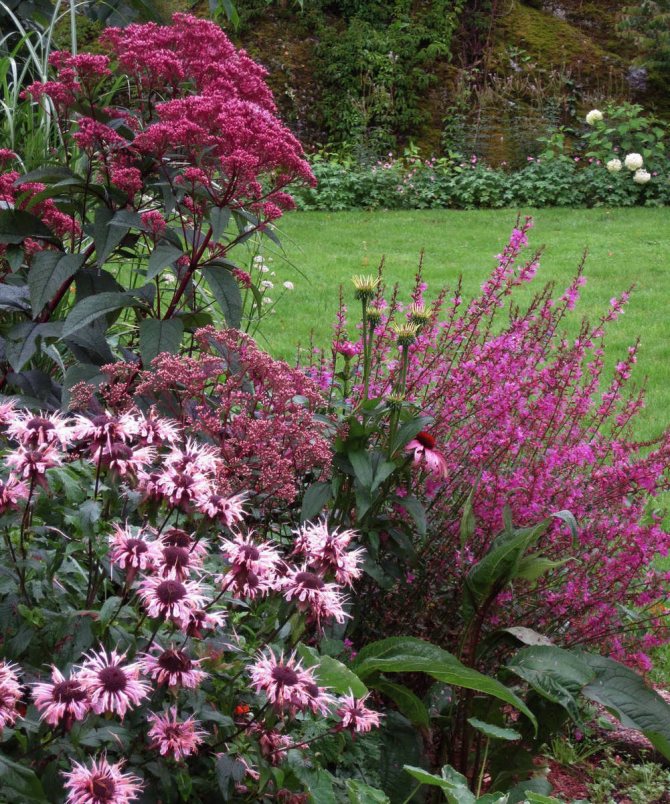

Nearby, you can plant a bubble, a mock orange, bushes of park roses or lilacs.
The majestic beauty of the stethoscope is emphasized by low decorative deciduous plants, for example, hosta, heuchera.
When using a perennial in a flower garden, consider its tallness, so plant it in the background.
The bush of the bush will look very good if tall cereals, heleniums, rudbeckia, echinacea, delphiniums are located nearby.
Considering the late appearance of shoots in the spring (approximately, in May), plant the place on which the birchwood grows with early primroses: crocuses, snowdrops, scylla or corydalis.
Then, in early spring, this piece of land will not look dull.
This culture is absolutely not aggressive and does not at all suppress nearby growing plants.
Skeleton in landscape design
The steep bushes are quite tall, so they are great for decorating a variety of buildings in the garden and as a backdrop for other garden plants. Since the steep loves moisture, it can be planted along the edges of reservoirs in order to decorate them.The rosewood in combination with other flowers creates a unique and original garden landscape design. Thanks to Evpatorium, the garden will not only be very beautiful, but also have an incredible delicate and sweet aroma.
As for floristry, Evpatorium retains its freshness and unique delicate aroma for a long time after cutting. The combination of the stethoscope with other extraordinary flowers makes it possible to create original and very interesting flower arrangements that will delight with their beauty for a long time, conquer with an incredible aroma and retain their freshness.
Bone Stem Care
Bone sap does not require much attention to itself, and caring for it is not difficult. You just need to follow the general recommendations for growing perennials.
How to water
So that the bush does not just take up space on the site, but also pleases with abundant flowering, do not forget about watering.
It should be systematic and abundant, especially if the summer is hot and dry.
Mulching the soil under the bush will help preserve moisture. Try to renew the mulch as often as possible, as it decomposes quickly thanks to frequent watering.
How to feed
If you apply the right fertilizers on time, this will immediately affect the appearance of the plant: a characteristic shine with a copper tint will appear, the leaves will acquire brightness and color saturation, the flowers will become more magnificent, and their number will increase.
Use mineral fertilizers dissolved in water: Kemira Lux, Zdraven, nitroammofoska, urea.
You can also feed it with wood ash, compost, bone meal, and add humus.
Three basic dressings are enough - the very beginning of spring; summer, when the bush is gaining color, and autumn - before wintering.
How to prepare for winter
Before the onset of winter, cut off the shrub, leaving stems 10-15 cm high.In addition, shelter is not required, since an adult bush is frost-resistant.
Take care only of young seedlings, covering them with spruce branches. Place humus under each bush, about the size of a bucket, this will help the plants survive the cold.
When to transplant
Bone sap does not like to be disturbed in vain, therefore, he treats frequent division and transplants badly.
These activities affect its flowering and appearance. If such a need has arisen, then it is better to do this in early spring, before the growing season has begun.
Keep in mind that in one area a bush can grow for 8-10 years, so initially choose the right place for planting.
If, nevertheless, the transplant is inevitable, then together with the roots, dig out a large clod of earth and move the bush to another place as carefully as possible.
How to trim
As mentioned above, pre-winter pruning is carried out in the fall.
With the onset of spring, close-knit shoots emerge, and the bush quickly restores the "lost" crown.
Recommendation. It makes sense to thin out the shoots, leaving the strongest and tightest. After that, the inflorescences will become larger, and the flowering will be more abundant.
In autumn, if you do not want the breeding of the steep by self-seeding, cut off all faded inflorescences.
Do I need to tie
If the bush grows in an open area, then it is better to tie it up to a support so that wet heavy inflorescences do not break off when gusts of wind or in rainy weather.
The correct solution would be to plant a perennial next to a fence, wall or fence.
Bone sap: briefly about the flower
A native of the tropics, the planting and caring for which allowed him to find his place on our lands. It is a perennial plant with a strong root system. The stems of the shrub can grow up to 2 meters in size. Dense foliage extends along the entire length of the stem. Midsummer is the time when bright blooms begin to adorn the green foliage. 25 cm inflorescences form delicate flowers that adorn the plant and the estate as a whole.The slope is very popular in landscape design, it is able to ennoble the unsightly corners of any summer cottage, especially the sunny ones.
You can see such a gorgeous sight in your garden, if you are not too lazy and plant seedlings. Perhaps planting will be the only difficulty that is experienced when breeding this plant.
Propagation of the stethoscope
Bone sap reproduces in several ways:
- seeds;
- dividing the bush;
- green cuttings.
With vegetative propagation, it is possible to preserve the characteristic features of the variety, because cross-pollination will not occur.
Seeds
Seeds can be bought at a gardening store, collected from a ripe inflorescence in the fall, or wait for self-seeding.
Sow seedlings in mid-March using small containers and good soil.
Do not deepen, just spread them on the surface of wet soil and lightly sprinkle with soil. Stretch the film or lay down glass to create a greenhouse effect.
After germination (after 15-20 days), the shelter must be removed. When the fifth real leaf appears, unpack it in separate containers. Plant on a flowerbed after warm weather.
Self-seeding that has fallen into the soil after flowering will give abundant shoots in the spring. Leave the strongest shoots. Such plants will bloom only in the third summer.
Dividing the bush
Bushes that have crossed the five-year line can undergo division. Both spring and autumn are suitable for this procedure, but it is still better to divide in the spring.
After the plant has woken up and started to grow, cut the rhizome with a spatula or knife into several parts with at least three buds.
Do not hesitate, plant them in the prepared soil, watering well.
If you decide to purchase a parcel, for example, from a neighbor, when he will share his bush, then the best time for this is September.
The plant needs time to take root before the onset of frost.
Cuttings
Another breeding method is cuttings. Feel free to plant the cuttings directly into the soil in the spring, or grow them like seedlings in pots and plant them in the summer.
Propagation of steep sap with root cuttings is perhaps the easiest way.
In the spring, separate the shoot and its underground part from the main bush, place it in a container with damp earth and put it in a greenhouse.
A quickly rooted seedling will grow there all summer, and plant it on the site chosen for planting only in August.
When and how it blooms
The most popular types of stethosis are:
- hemp, which was named for its resemblance to hemp leaves;
- the wrinkled look is subdivided into several varieties. For example, wrinkled Chocolate with black leaves is popular. Also known is the Braunlaub variety, which has brown leaves and buds;
- purple with bluish-green stems and thyroid inflorescences;
- Spotted steak has several varieties, among them the spectacular spreading Atropurpureum with strong stems and wine-red flowers;
- The tubular species is distinguished by the Album variety, which grows into upright trapezoidal bushes three meters in height.
Flower shapes
Small flowers are collected in about 12 pieces. in the shape of a basket. Shield inflorescences reach 12 cm in diameter.
Flowering period
Blossoming time is August and September.
For your information! Plants also attract attention in October, when a silvery ebb and fruits with seeds appear on them. The smell of vanilla is present throughout the growing season.
Changes in care during flowering
With the onset of flowering, care is no more difficult than usual. It is necessary to monitor the condition of the soil, namely, its moisture, and also remove weeds as they appear on the site.
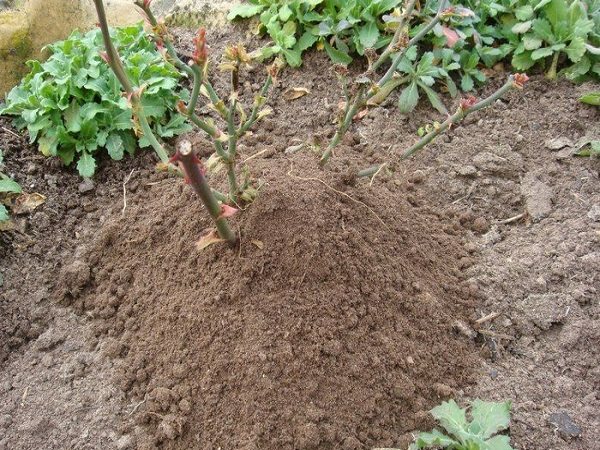

Planting a perennial in a vegetative way
Pest and disease resistance
Bone sap will not bother you with its diseases, it has good resistance against them.
It is not susceptible to pest attacks either.
The only pest that can appear on this perennial is the miner.
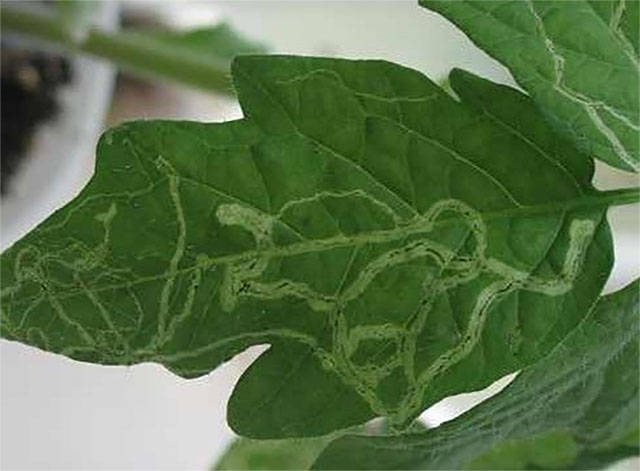

It settles inside the leaf, making a kind of "tunnels".
The mineral can be detected by the characteristic pattern on the surface of the leaves.
The most effective way to fight is to collect and burn such foliage.
If the area is large, use an insecticide such as Actellic.
Types and varieties
There are more than 600 plant species in the genus of bony. The most popular among gardeners are:
- wrinkly;
- purple;
- spotted;
- tubular;
- hemp.
Let's talk about them in more detail.
Skeleton wrinkled
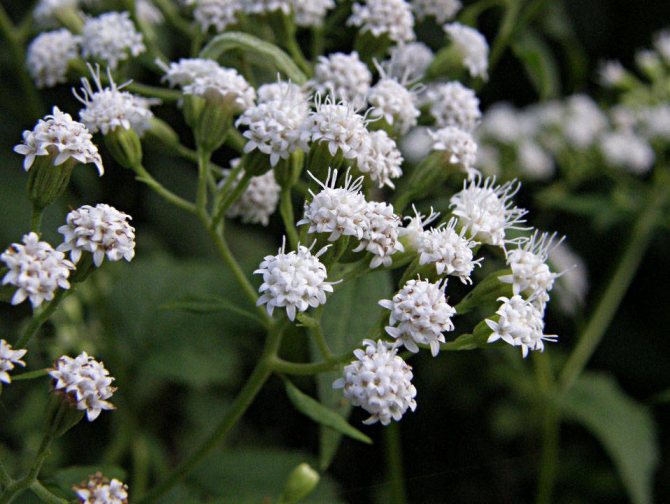

Eupatorium rugose
The height of the bush reaches 1.5 m, the leaves are oval-ovate, framed by denticles. The color of the shoots is dark, almost brown.
The bristle rose blooms late, closer to August, blooms almost until the end of October, releasing white lush inflorescences.
The most famous variety is Eupatorium Chocolate.
Bone sap spotted
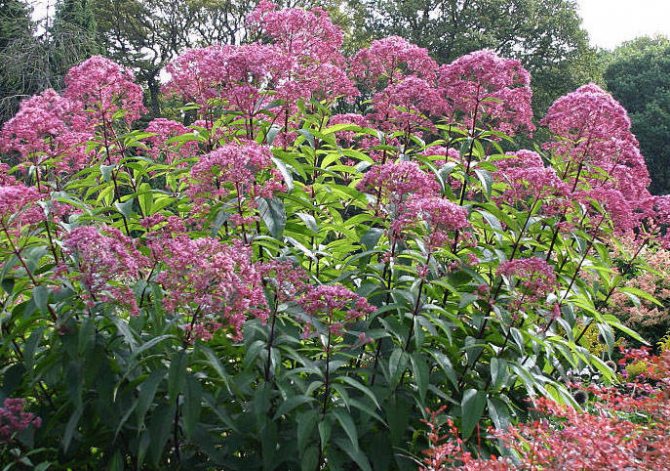

Eupatorium Maculatum
The difference from other species is its impressive size (up to 2 m) and a little "rough" shape.
It has an irregular coloration of the stems, on which pink spots are visible, hence the name of the species - Skeleton Spotted.
The leaf cover is dense, the color of the foliage is dark green or gray. Due to its size and density of leaves, it can act as a hedge.
The most famous variety is Atropurpureum.
Skeleton purple
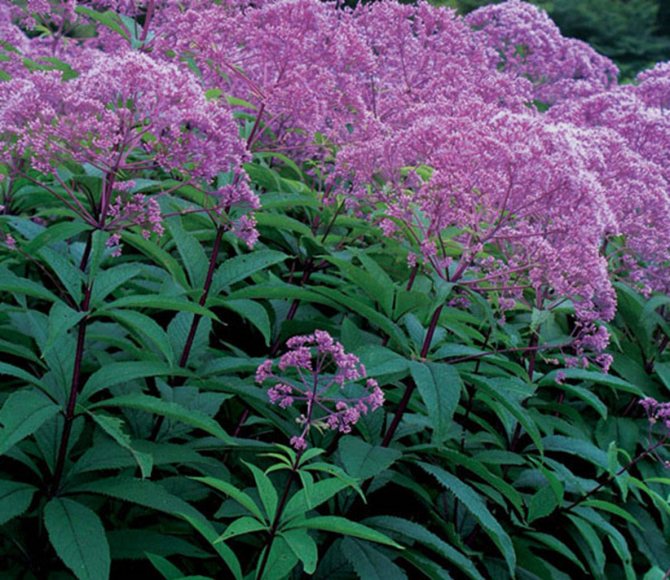

Eupatorium purpureum
This type is most popular with gardeners, as there are many similarities to the lilac bush.
The height of the bush is about 150 cm, no additional garter is required. Blooms in July, blooms until the end of August with pale pink or purple inflorescences.
Possesses increased cold resistance.
Bone sieve tubular
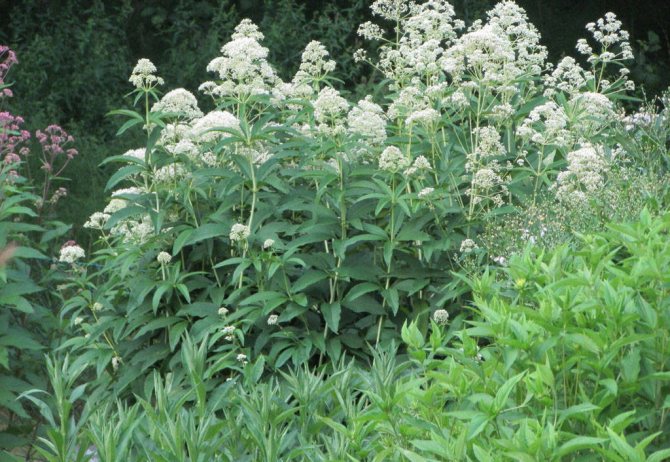

Eupatorium Fistulosum
A powerful plant, up to 3 m high. It blooms in August, blooms until the end of September with lush white inflorescences.
The color of the stems is light burgundy, at the end of the growing season it becomes paler.
Hemp sap
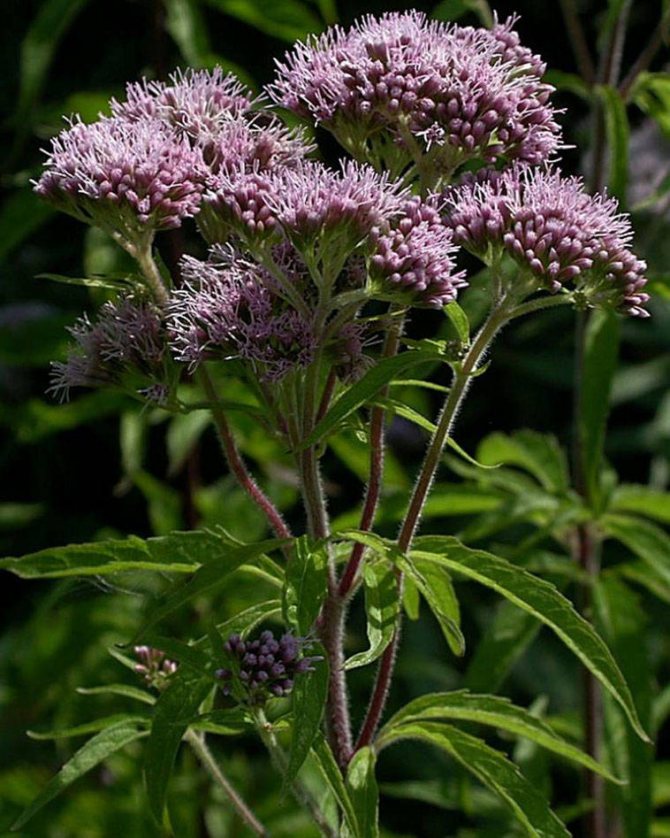

Eupatorium Cannabinus
Hemp sap can be found not only in the summer cottage, but also in the wild next to water bodies, in a damp and swampy place.
Compared to other species, it is rather undersized, the height ranges from 0.5 m to 1 m. It blooms from July to the end of August, the color of the baskets is silvery-pink.
In the shape of the foliage, it is similar to a hemp bush, hence the name - hemp bush.
A flowering steep tree will give the garden a special elegance and attractiveness, and the aroma of inflorescences will attract honey insects, which will be useful for pollination of other plants on your site.
CherryLink plugin not found
Description
Evpatorium has a straight and rather long stem. The leaves are opposite to each other, sometimes they can be staggered, have a rich green color, pointed towards the end. The flowers of the steppes are tubular, small in size, and range in color from white and light pink to lilac and lilac. Flowers are collected in inflorescences resembling baskets. The height of the shrub can reach 2 meters.
Flowering begins in late summer - early autumn (August-September). The plant remains attractive even after it has faded: in October, its inflorescences acquire a silvery color, and then fruits - achenes are formed.
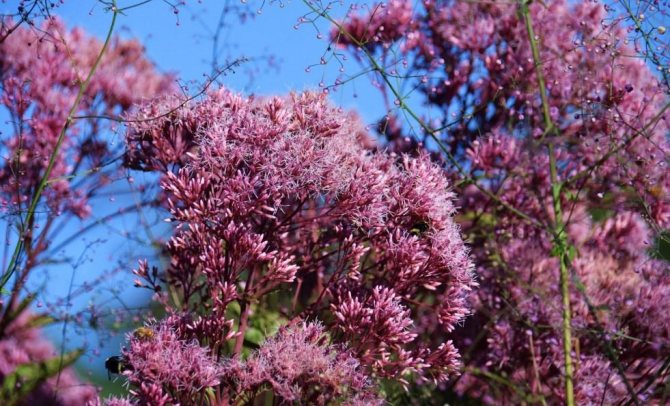

It begins to grow back by the end of spring (around the beginning of May), since frosts and cold weather have ended, which poses a threat to plants that have appeared too early. The shrub grows quite compactly, thereby not interfering with other garden plants located nearby. It is such qualities as compactness, height and slenderness that have allowed gardeners and landscape designers to classify the steep as an "architectural" plant. Photos of the bed in landscape design are presented below.

